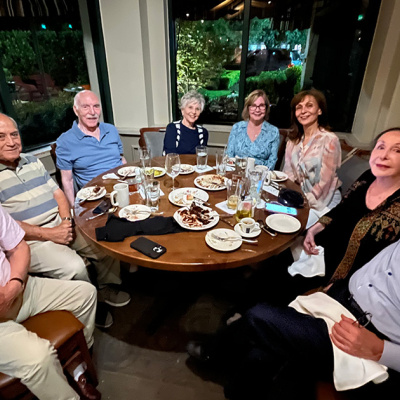One of America's Greatest Living Artists Pops Up at UT
[caption id="attachment_66387" align="aligncenter" width="630"]

"Pool #2," from the Portfolio Pools, 968; printed 1997. © Ed Ruscha[/caption]
It’s hard to overstate the influence Edward Ruscha has had on contemporary American art. His body of work, pieces of which are exhibited in the likes of the Metropolitan Museum of Art in New York City and the National Gallery of Art in London, spans more than five decades, a timeline that took the artist from the late 1950’s Pop Art movement into the 21st Century.
Ruscha’s bold signature style, born out of his love of literature, his childhood in Oklahoma, and his time in Southern California, can be seen in some of his most famous pieces, including 1966’s “Standard Oil” and 1979’s “Hollywood Tantrum,” and have cemented him as one of America’s most important living artists.
Nestled between Ruscha’s four major shows this year—Joslyn Art Museum in Omaha, Nebraska; Louisiana Museum of Modern Art in Denmark; the National Gallery in London; and the Vienna Secession in Austria—fans can explore the artist’s work and creative process at the Harry Ransom Center’s exhibit Ed Ruscha: Archaeology and Romance. Opened in August, the show runs through Jan. 6, 2019.
Unlike Ruscha’s 2018 retrospectives at, say, the Vienna Secession, the Ransom Center exhibition is far more intimate, providing a glimpse into the mind and process of the artist, resulting in what something that Ruscha himself likens to “gumbo.” Using archival materials, visitors have the opportunity to see the artist’s process from conception through completion.
The show is also the first major exhibition to draw on the Ransom Center’s Edward Ruscha Papers and Art Collection, which was acquired in 2013, and includes books, paintings, and photos, as well as more than 150 pieces of unpublished materials (think notebooks, sketches, and journals).
“This will be the first time our exhibition audiences will have the opportunity to view much of this material, which was essentially filed away in Ruscha’s studio before it came to the Ransom Center,” explains Jessica S. McDonald, the Nancy Inman and Marlene Nathan Meyerson curator of photography, and the exhibit’s curator. “The Ransom Center is one of just a few institutions that has acquired materials related to the stages of production leading up to his finished works.”
With an editor’s eye, McDonald has stripped away the chaos, presenting the materials in a way that takes the viewer step by step through the creation of some of Ruscha’s most iconic pieces.
Among the key themes in Ruscha’s work is the iconography of the Western U.S. and that myth of the open road that’s so deeply ingrained in the American psyche. Gas stations, classic Hollywood imagery, and post-World War II commercial signage appear often in Ruscha’s art, as do phrases like “Honey, I Twisted Through Traffic to Get Here” that harken back to Ruscha’s love of literature and words.
Ruscha, now 80, was born in Nebraska and grew up in Oklahoma. And though he decamped for Los Angeles more than 50 years ago, where he still lives and works today, when it came time to chose a steward for his archive, he selected the Ransom Center in part because of its prestige.
“It’s an honor and a privilege to join the Harry Ransom Center with volumes of my history that were previously in out-of-order disarray and confusion,” Ruscha says. “The organized collection brings a solid clarity to the material.”
McDonald is responsible for the clarity of that material. Though the curator says “countless” shows could be built around the collection, when she began the process of creating the exhibit, she returned to a common theme in that artist’s work: books.
“Because Ruscha shaped the collection around his well-known and widely influential artist’s books, I chose to take those as the starting point,” McDonald says. “One of my own scholarly interests is in the intersection of photography, art, and books in the 1960s, so this has been an especially rewarding project to work on.”
Ruscha has become indelibly tied with the idea of Los Angeles cool. (A profile of Ruscha in the Summer 2018 issue of Vanity Fair used some variation of the word “cool” 15 times.) And though he has called The Golden State home since 1956, after moving there to study at what is now known as the California Institute of Arts, Ruscha says he is still inspired by Oklahoma and Texas.
“I see Texas and Oklahoma as one big state with much in common. Both share similar geography, history, and culture. One just happens to be north of the other,” Ruscha says “I came out of an Oklahoma that had many recent dust bowl hardships, and I inherited some kind of strength and enlightenment from all it gave me.”
Credit: Edward Ruscha Papers and Art Collection, courtesy Harry Ransom Center






